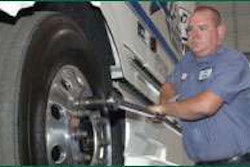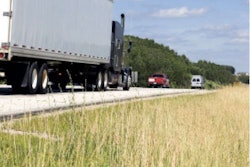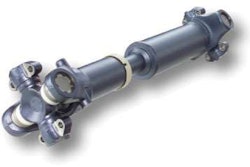
Fans of the 1970s TV show “The Six Million Dollar Man” will remember how astronaut Steve Austin was introduced during the opening credits: “A man barely alive. Gentlemen, we can rebuild him. We have the technology.”
The same can be said about a modern diesel engine. The technology is available to rebuild equipment that has been reduced to little more than a hulking mass of metal – and at a price considerably lower than the $6 million bill for a bionic superhero.
But the work may not be as frequent as some experienced technicians rememberM. “We’re now talking about B-50s at 1.2 million miles on these engines. When we started in this game it wasn’t unusual to have a B-50 of 400,000 miles,” observes Jay Wagner, MAHLE Clevite heavy-duty product specialist, referring to the point at which one in every two engines would require an overhaul.
Brian Gordon, a regional manager at IPD, offers an observation that is less optimistic. “The days of a million-mile engine have come and gone,” he counters, largely blaming exhaust gas recirculation (EGR) systems for introducing more contaminants into engine crankcases, shortening the life of rings, cylinder liners, piston ring grooves and more. He suggests a typical B-50 life is more likely to fall somewhere between 600,000 and 700,000 miles depending on the engine model.
Ironically, that shorter life could actually improve the case for an overhaul. These engines will be sitting in younger trucks, so there will still be plenty of life in other components.
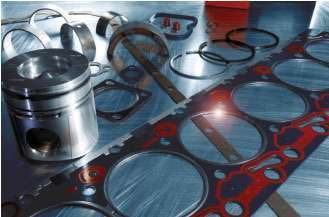 The decision to rebuild an engine must make economic sense. Factors to include are the remaining life of other components on the truck and which components on the engine need to be remanufactured or replaced.
The decision to rebuild an engine must make economic sense. Factors to include are the remaining life of other components on the truck and which components on the engine need to be remanufactured or replaced.Of course, the ultimate need for an overhaul will be dictated by more than the mileage on the odometer. Oil analysis programs can identify spikes in the volumes of unwanted wear metals and other contaminants.
“If metal particles are present, this could point to failure of the rod, main bearings or cam bearings,” explains Mack Engine Product Manager Danny Long. “An oil analysis will also indicate if there is a high concentration of fuel or antifreeze mixed with the oil. If so, the piston rings could be failing or excessive wear to the piston liners has occurred. Antifreeze contamination can cause premature wear to the bearings as well. The next step is to run a compression test on each cylinder. Low compression can be caused by worn liners and piston rings, or even worn valves.”
Those who operate the equipment can identify other factors such as engine knocks or misses, smoke from the exhaust, increased fuel consumption, higher blow-by rates, and an overall drop in engine performance, notes Brad Everett, Caterpillar’s on-highway senior product support analyst. “A more general indicator would be mileage, engine hours or fuel consumed as measured by the engine ECM [electronic control module].”
The vehicle’s application will dictate how important one factor will be over the next, he explains. An engine exposed to high idle times would likely be evaluated based on engine hours or the gallons of burned fuel instead of the mileage recorded on an odometer.
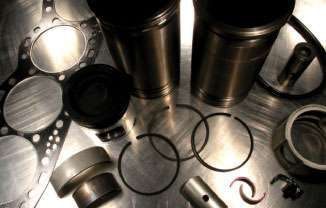 What needs replacement will vary, but generally the water pump should be replaced along with the rod, main and cam bearings, pistons, piston rings and liners, oil pump, thermostat, seals and gaskets.
What needs replacement will vary, but generally the water pump should be replaced along with the rod, main and cam bearings, pistons, piston rings and liners, oil pump, thermostat, seals and gaskets.A test on a dynamometer might offer the most telling information of all. The Caterpillar representative refers to a test on a chassis dyno which measures the engine’s fuelling rate, horsepower, torque and blow-by. “There are established specs for all of these and if any of these are out of spec, there may be something wrong inside the engine,” he says.
Ultimately, the most important factor in the decision to rebuild an engine may come down to a matter of economics. Virtually anything could be rebuilt. If the lower bore on a cylinder block is in terrible condition, for example, it can be cut out and enhanced with metal inserts; if the crankshaft journals and connecting rod journals show signs of excessive wear, it may be time to remove the cylinder block.
But there is an array of other components which can add to the complexity and cost of the job. An electronic fuel injector can cost $3,000 to $4,000, and there might be six of those to replace.
Many engines will also include two turbos in the turbocharger, each of which can potentially fail, Gordon notes.
Rick Cape, Mack’s remanufactured technical product manager, refers to the way the water pump should be replaced with the injector cups and even the injectors – along with the rod, main and cam bearings, pistons, piston rings and liners, oil pump, thermostat, seals and gaskets that should be part of any rebuild.
Wagner, however, looks at another price-related issue that should increase the interest in rebuilds. The latest generation of engines created to meet the emissions regulations of the U.S. Environmental Protection Agency are more expensive than the generation that came before. That makes them worth saving.
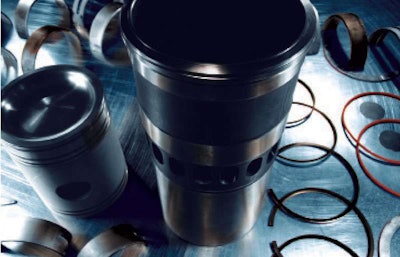 Advanced manufacturing processes have eliminated much of the technician prep work for replacement components. The shop environment where the rebuild is taking place also needs to be as clean and free of contaminants as possible. Even microscopic debris can wreak havoc on engine performance.
Advanced manufacturing processes have eliminated much of the technician prep work for replacement components. The shop environment where the rebuild is taking place also needs to be as clean and free of contaminants as possible. Even microscopic debris can wreak havoc on engine performance.But the most affordable rebuilds will always tend to be those that are planned through the regular analysis of the oil, and before a catastrophic failure. If a rod breaks while the vehicle is cruising down the highway at a high rate of speed, the damage always will be more severe. “That piece of metal swinging around can almost cut the block in half,” says Wagner.
“If you wait until a major failure, you risk having to replace additional parts as a result of contingent damage, driving up the overhaul cost significantly,” Everett agrees. “If you can, it’s better to plan ahead, budget for an overhaul at the appropriate time, and take advantage of the built-in second life of the engine.”
Repair shops should certainly play a key role in that guidance.
The work may even be more than a matter of just fixing the engine. Thanks to different updates, a shop can take steps to enhance the engines that need to be rebuilt.
“If there’s been any design changes or improvements to a specific component, the servicing dealer technician can make sure the latest and greatest for the customer’s specific engine model is incorporated into the overhaul. Additionally, there are sometimes updates to engine ECM software that may enhance the overall performance of the engine,” Everett says.
“Depending on the age of the engine, a piston redesign may have occurred,” Long adds. “This is typically done to reduce NOx emissions or strengthen the piston for quality reasons. An ECM reprogram may also be needed in conjunction with the piston replacement or as a standalone upgrade. Higher compression [meaning more power], less oil consumption, improved fuel economy and lower emissions will be the ultimate gain.”
The end result is better. Stronger. Like the Six Million Dollar Man.
But there are limits. A shop that decides to boost a 350 hp engine up to 450 hp by spending nothing more than another 20 minutes with the ECM may be heading into dangerous territory. It is possible, Wagner admits, but the changes can have a “cascading” effect on the other drivetrain components that were never built to handle the added stress.
“Trying to figure out all the repercussions of trying to change the horsepower is sometimes a worrisome thing,” he says. “It’s like a light bulb. The hotter it burns, the less time it burns.”
REQUIRED PARTS
The list of components needed for a rebuild will seem pretty familiar from one engine rebuild to the next. There will be new pistons, rings, liners and seals in addition to the cylinder head, but the job can involve much more than that. An in-frame overhaul can still involve machining and cutting counter bores into shape, along with the cylinder packs, injectors, and water pump. Meanwhile, an out-of-frame overhaul will involve sending the block and related components to a machine shop.
It is important to consider the nature of any problems that led to the decision to rebuild the engine when deciding on the steps and parts which will be required, Wagner says. If an engine was running poorly for no apparent reason, a shop may be able to identify an issue such as a lost cam lobe. An overheating engine may lead to questions about the cooling system. And an intake manifold full of oil should lead a technician to investigate the condition of the turbocharger.
The decision to replace parts such as aftercoolers or water pumps will often be dictated by a schedule set by the manufacturer, Wagner adds.
Different nameplates introduce needs of their own, leading sources like the Engine Builders Association (AERA) to publish regular bulletins about rebuilding procedures.
“Sometimes there’s a fairly good list of them on any engines,” Wagner says. “They really are the ones calling out the anomalies.”
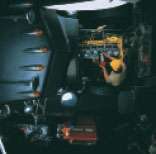 Newer, emissions-compliant engines cost considerably more than their predecessors. This higher purchase price may make owners more likely to rebuild in the future.
Newer, emissions-compliant engines cost considerably more than their predecessors. This higher purchase price may make owners more likely to rebuild in the future.Material choices will always play an important role as well. For example, a 14.5:1 piston is simply not an alternative for the 15.5:1 design used in the original engine. “I’m amazed how many pistons they’ll make to fit the same size bore,” Wagner notes. The wrong choices are even more likely when the parts are chosen visually. “You’ve got to know what size your crank is,” he adds. “If you put one in too tight the engine won’t turn.”
Main bearing caps also need to be installed in the proper order. “A rod cap is exclusive to that rod,” he explains, stressing the fact that the parts are not interchangeable. “If you have six rods and put No. 5 cap on No. 6, you’re going to have a rod failure…you have to put it in the right direction, too.” Arrows will also indicate the front of a piston in many cases. “If you’re not paying attention and put the pistons in backwards and the valve hits… it does tend to make a lot of noise!”
Cape, meanwhile, notes how a crankshaft may need to be turned or polished to remove the scratches made by failing bearings. “These parts need to be inspected during the parts cleaning process to identify worn parts,” he says. “Sometimes a technician can simply inspect the part and tell if it is worn beyond its service life; sometimes a technician must make measurements using precision tools.”
But Gordon also warns that there are different interpretations of “new” components, and that could affect the ultimate life of the rebuilt engine. Cylinder packs may simply include used and reconditioned parts. “You can’t expect new life out of used parts,” he insists. “It works the same thing with cylinder heads and water pumps.”
CLEAN CONDITIONS
Another source of future failures may have nothing to do with the choice of parts at all. Few shops can match the sterile environment of an assembly line, and every bit of contamination threatens the life of a rebuilt engine.
“Cleanliness is the No. 1 thing all the time,” Wagner says, noting how debris can be displaced every time a part is moved. When working on an in-frame overhaul, he stresses the need to seal off the fuel system and close the lines using plastic caps. When machining a cylinder, the adjacent cylinders will also need to be sealed with caps of their own.
Gordon offers advice of a similar nature: sealing injectors into plastic bags, closing openings such as fuel lines with tape, and sealing the turbo’s exposed oil galleys. The bases of oil filters, coolant filters and fuel filters should also be covered and protected. In fact, he recommends leaving the old filters in place until they’re ready to be replaced.
Dirt even seems to be attracted to the oil holes in connecting rod journals. If left behind, it is likely to jam itself into a bearing, thanks in part to changes that have included a thinner, harder coating. “They reduced the amount of that babbitt material to 30 to 40 hours. It doesn’t have the ability to tolerate contaminants like it used to,” he says.
Some contaminants are unknowingly introduced in the name of cleaner parts. The same solvent that cleans one surface, for example, can wash contaminants into the connection rod journals. Meanwhile, the material used in bead blasting can jam itself into plenty of crevices, and it will only be knocked free by the oil in a running engine.
“That’s going to be embedded in all the bearings,” Wagner says.
His solution? Don’t bead blast. Other cleaning media, such as walnut shells, will be a better option. “You can do anything you want,” he continues, “but only as long as you’re careful enough to clean everything out.”
It is about more than avoiding debris. A Scotch Brite scouring pad can peel the sealing bead off the top of a liner; an abrasive wheel used to remove a gasket can ruin the surface of the spacer plate underneath; and glass or steel shot will actually wreak havoc with the smooth surface of a ring even though it appears to leave a mirror-like appearance. “You roughen it to the point where it makes it hard for the ring to rotate,” Gordon observes.
Wagner notes how the thinking extends to the newest parts. Some technicians think new liners need to be re-honed, even though today’s refined manufacturing processes have eliminated the need for some of the preparation. The liners are already “plateau honed,” which means that any microscopic peaks are already knocked off the surface. “The honing stone they use to get the right cross hatch is very precise,” he adds.
Even the addition of some extra lubricant can cause some trouble. Few of the seals are made simply of rubber, and some of them do not respond well to a technician’s grease.
“Most gaskets are designed to put on with no sealant,” Gordon observes. “If you think putting a bunch of silicone on it is helping the situation, you could be making it worse.”
The gasket sealer can also squeeze into an engine and plug an oil cooler. “Look at what’s in the end of the oil cooler and a lot of times it will be silicone,” he notes.
His solution? “Liquid dish soap will almost never create a problem.”
QUALITY CONTROL
A few extra tests and inspections will also avoid trouble as the renewed engine continues its journey.
Engines with overhead cams, for example, have introduced the need to inspect the cam shaft and cam followers. “Cam bearings are now considered normal in an in-frame overhaul,” Gordon says, noting how such inspections had been considered an option unless a customer was willing to have a radiator removed. “You just left them alone, crossed your fingers and hoped they were fine.”
Then again, with an ISX Cummins, the radiator actually needs to be pulled out to access the head bolts. The access is already granted.
Ultimately, the surface of the cam shaft and cam follower should be inspected for signs of pitting and fracturing – the spalling that will lead to hairline cracks where cam followers run on pins. “There are specs on how much movement can occur on the cam follower roller itself,” he adds.
Even though today’s injectors are more durable than their predecessors, it can also be a good idea to test their performance before reinstalling existing versions in the engine. And turbochargers deserve a look of their own. “There’s a thrust bearing in there,” Gordon explains. “You can check for end thrust to make sure you have proper end-to-end movement.” If the compressor wheel touches the housing, “bad things happen.”
The final test on a dynamometer may include the most important inspection of all.
“If something is going to go wrong it’s going to go wrong on the dyno,” Wagner notes. If the engine is tested when outside the frame rails, it will also be easier to identify the source of something like a coolant leak.
Since the material on the face of any of the new rings is harder than ever, the final break-in period for the renewed engine will be an important final step, Gordon adds. It may be possible to seat the components by coupling the truck to a trailer and dragging the brakes, but a dyno ensures that the work has been done correctly.
It is further proof that a shop can rebuild it…if it has the right technology. n

